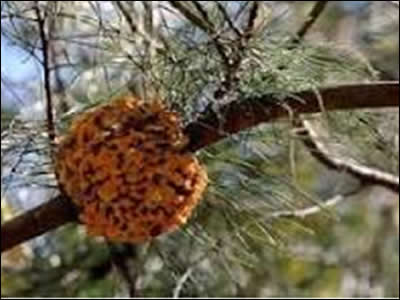RUST
Scots pine is the pine species most susceptible to a form of rust caused by a fungus. It can cause severe distortion and dieback. The first signs of rust are frequently pustules on the needles or leaves, especially on the lower surface. The pustules are usually powdery due to the release of large numbers of microscopic spores.
Rust can spread very quickly by means of their abundant spores, it is important to pick off and remove all diseased material as soon as it is recognised. Pustules are orange or dark brown and need a moist environment to germinate. They are most severe in the damp, humid conditions of summer and autumn. The disease is spread by air, aphids, rain splash and infected cutting tools.
A number of chemicals are available for treatment. Murphy’s ‘Tumbleblite’ is probably the best, with standard fungicides varying in their effectiveness.


Scots pine rust develops pustules which should be removed before the infection can spread.